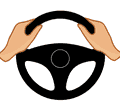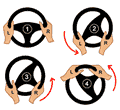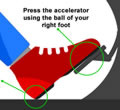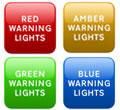During your first automatic driving lesson, we covered the cockpit drill. After you’ve carried out the cockpit drill, you’ll then move onto the car’s hand controls, foot controls and auxiliary controls.
At this early stage of learning to drive, we concentrate on the fundamental hand, foot and auxiliary controls essential for you to drive safely.
Hand Controls
Your car’s hand controls include the steering wheel, gear selector lever and the handbrake or parking brake.
 Steering Wheel Hand Positions
Steering Wheel Hand Positions
Here we explain the various steering wheel hand positions that you can use for learning to drive along with what the examiner is looking for on the driving test.
![]()
 Push and Pull Steering Method
Push and Pull Steering Method
This tutorial explains the push and pull steering method used by driving instructors to teach learner drivers. Step by step diagrams and video guide.
![]()
 Automatic Car Gears Explained
Automatic Car Gears Explained
Essential car controls include the automatic gears. These tutorials explain how to use the automatic gears; from the gear lever to the various letters and numbers.
![]()
 How to Use the Handbrake in an Automatic Car
How to Use the Handbrake in an Automatic Car
During your first driving lessons, you’ll need to understand how the handbrake or parking brake work. This tutorial explains how to apply and release the handbrake or parking brake in an automatic car.
![]()
Foot Controls
Your automatic car’s foot controls include the brake and accelerator pedals.
 What Feet to Use When Driving an Automatic Car
What Feet to Use When Driving an Automatic Car
If you’re asking if you should use both feet when driving an automatic car, or you’re simply not sure, here we explain the best practices for which feet to use for the brake and accelerator.
![]()
 Learning How Car Brakes Work and How to Use Them
Learning How Car Brakes Work and How to Use Them
One very important part of learning to drive an automatic car is of course learning how to safely stop it. These tutorials teach you how your car’s brakes work and techniques for safely using your brakes.
![]()
 How to use the Accelerator in an Automatic Car
How to use the Accelerator in an Automatic Car
This guide explains how to use the accelerator in an automatic car, from foot position, moving off, moving off on a hill (hill-start), driving round corners, eco-driving and accelerating.
![]()
Auxiliary Controls
Your car’s auxiliary controls include the indicators, hazard warning lights, windscreen wipers and washers, vehicle lights, window demister.
 Where are the Indicators on a Car and How to Use Them
Where are the Indicators on a Car and How to Use Them
This tutorial which includes a video explains where the indicators are, plus how and when to use them. This is usually covered by the driving instructor during the first driving lesson.
![]()
 What are Hazard Warning Lights
What are Hazard Warning Lights
Tutorial and video for new learner drivers explaining what hazard warning lights are, how to activate them and when to use and when not use them.
![]()
 How to Use the Windscreen Wipers
How to Use the Windscreen Wipers
You’ll need to know how the windscreen wipers work not only for learning to drive, but for the driving test too. This tutorial explains how to use the front and rear windscreen wipers and washers, plus what not to do to avoid possible damage.
![]()
 How to use your Car Lights
How to use your Car Lights
This tutorial explains how to use your car lights; from where the car lights controls are located, what all the symbols mean (so that you know what each light does) and when you should use them.
![]()
 How to Demist the Front Windscreen and Rear Window
How to Demist the Front Windscreen and Rear Window
Windows often fog up while driving, so you need to know how to clear them. This tutorial explains how to demist the front windscreen, front door windows and the rear window.
![]()
Dashboard Gauges and Warning Lights
Your car’s dashboard gauges include the speedometer, rev counter and warning light indicators.
 Car Dashboard Gauges Explained
Car Dashboard Gauges Explained
Prior to driving the car for the first time, you’ll need a basic understanding on your car’s dashboard gauges and dials. Here we explain those important gauges and dials.
![]()
 Dashboard Warning Light Colours
Dashboard Warning Light Colours
When you’re setting out learning to drive, you’ll not be expected to know all warning lights, just a couple that are important for driving. Those lights are explained, along with what warning light colours mean.
![]()
